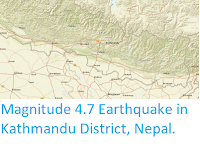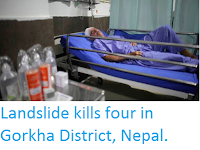Three people have died following a landslide in the Jajarkot District of Nepal on Sunday 1 September 2019. The incident happened happened at about 1.45 am, hitting the house in which Parbati Wali, 32, and her daughters Motikala, 9, and Dhansara, 3, were sleeping. All three people in the house were killed, with Parbati's husband, Dal Bahadur Wali, surviving with leg injuries as he was sleeping outside.
The scene of a landslide in Jajarkot District, Nepal, on 1 September 2019, that killed three people. Dinesh Kumar Shrestha/Himalayan Times.
Dinesh Kumar Shrestha
Dinesh Kumar Shrestha
Dinesh Kumar Shrestha
The incident has been blamed on torrential rainfall that has fallen across the area in the last few days. Landslides are common during the monsoon season in Nepal, which lasts from May to September, with the highest rainfall occurring in July. Landslides are a common problem after severe weather events, as excess pore water pressure can overcome cohesion in soil and sediments, allowing them to flow like liquids. Approximately 90% of all landslides are caused by heavy rainfall.
Monsoons
are tropical sea breezes triggered by heating of the land during the
warmer part of the year (summer). Both the land and sea are warmed by
the Sun, but the land has a lower ability to absorb heat, radiating it
back so that the air above landmasses becomes significantly warmer than
that over the sea, causing the air above the land to rise and drawing in
water from over the sea; since this has also been warmed it carries a
high evaporated water content, and brings with it heavy rainfall. In the
tropical dry season the situation is reversed, as the air over the land
cools more rapidly with the seasons, leading to warmer air over the
sea, and thus breezes moving from the shore to the sea (where air is
rising more rapidly) and a drying of the climate. This situation is
particularly intense in South Asia, due to the presence of the
Himalayas. High mountain ranges tend to force winds hitting them
upwards, which amplifies the South Asian Summer Monsoon, with higher
winds leading to more upward air movement, thus drawing in further air
from the sea.
Diagrammatic representation of wind and rainfall patterns in a tropical monsoon climate. Geosciences/University of Arizona.
See also...
Follow Sciency Thoughts on Facebook.








